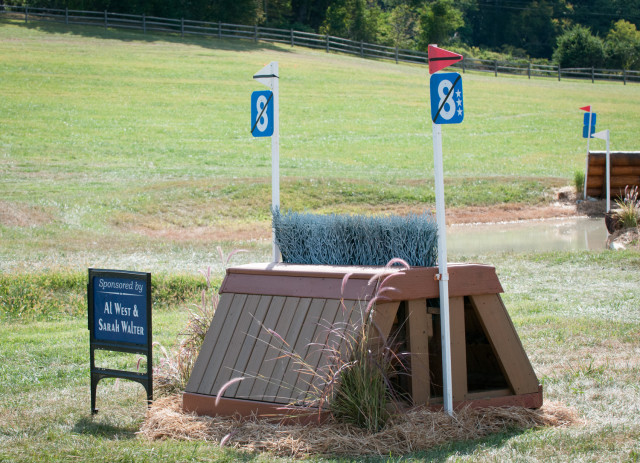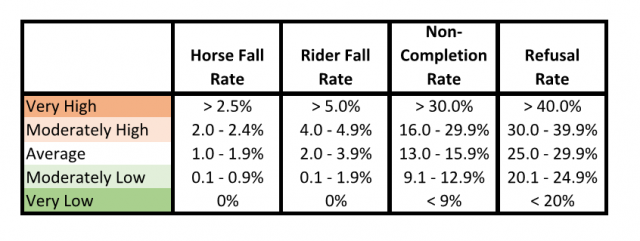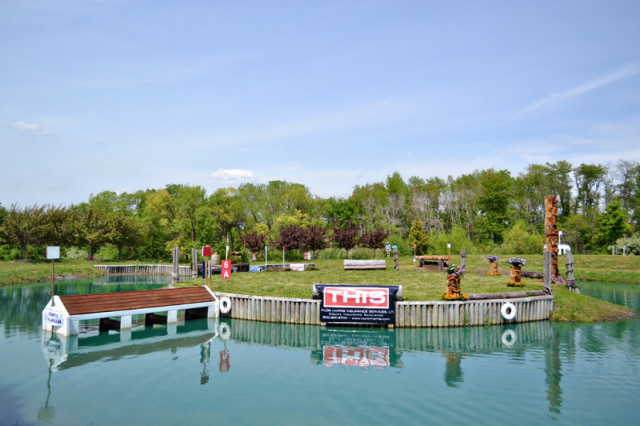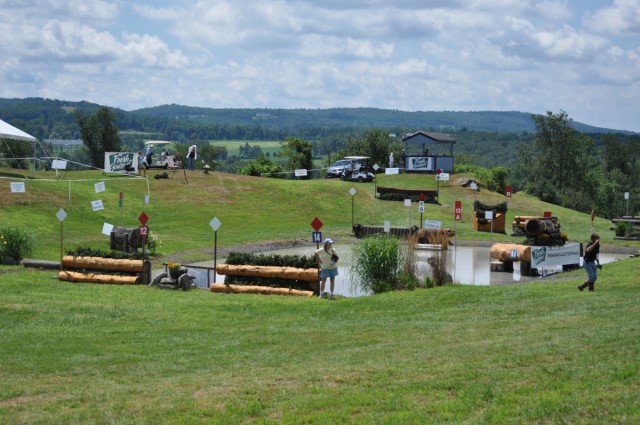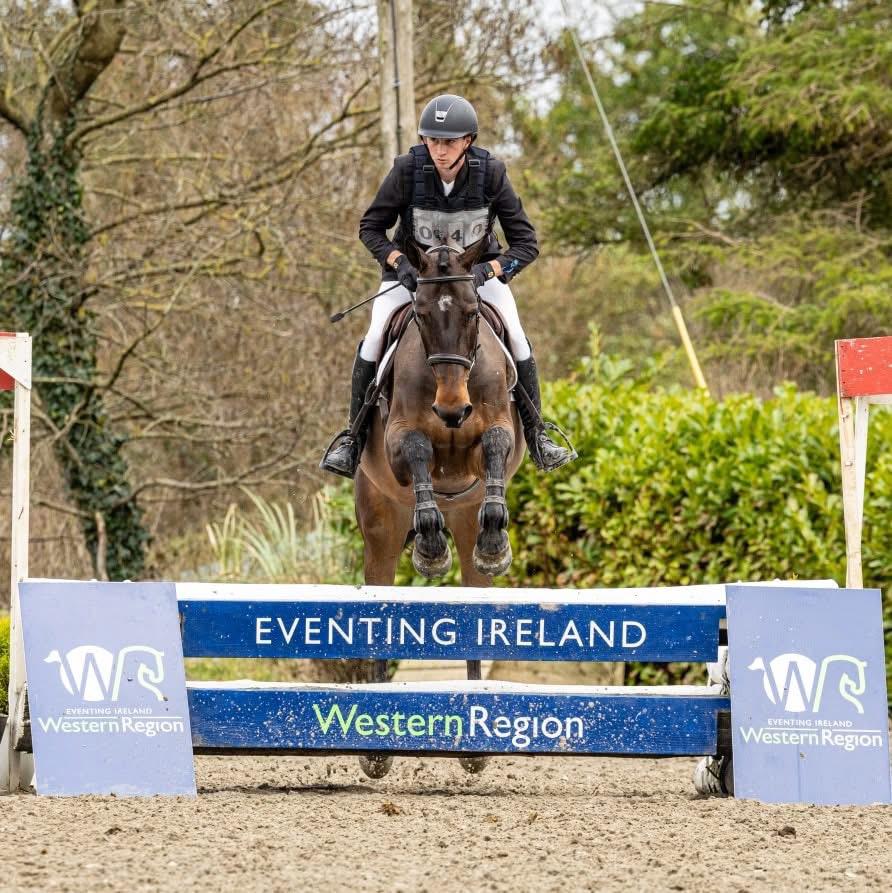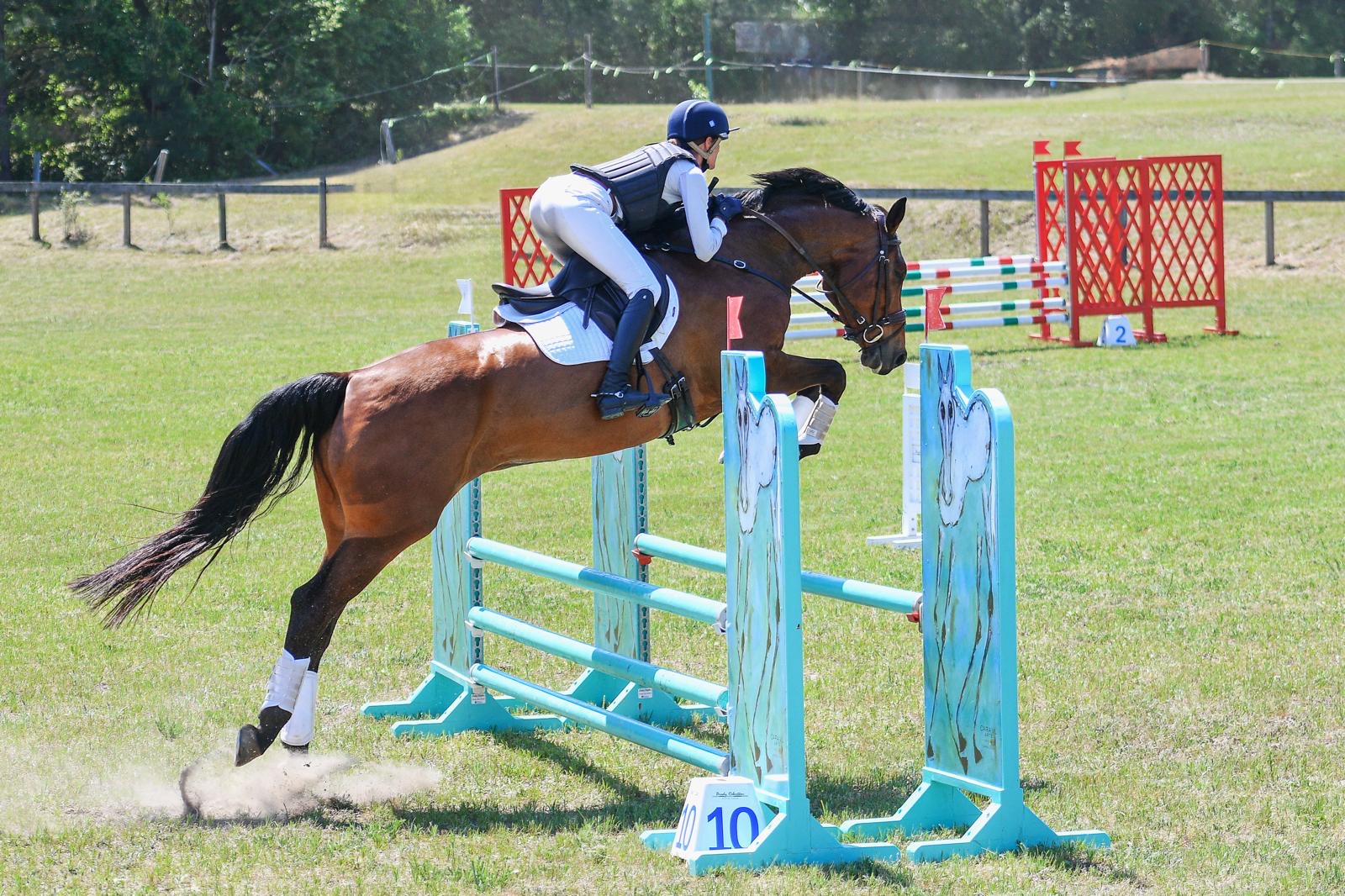It’s a new year, and with the advent of the new calendar gazes suddenly turn towards the possibilities of what a new season holds. Pencils are sharpened, horses are clipped, and suddenly the promise of a move-up seems more real than it did two weeks ago.
Where to move up is often a bit of an agonizing decision. Theoretically all events are up to the standard of their level, but let’s face it — there’s always that one event that everyone says is just a bigger version of the lower level. Word of mouth has been the traditional method for sniffing out these ‘move-up’ events, while move-up riders often steer away from so-called ‘stiff for the level’ events.
This year I got curious. A dear friend of mine is looking for the blue flag move-up and suddenly I found my data is useful on a personal level. Almost eight years ago, I made my own move-up to the blue flags, as blind as everyone else. That was two years prior to the inception of my work with Eventing Nation and the beginning of my data collection.
Today, I’m armed with five full years of data collection for North America and I wanted to give her the ability to make informed decisions. I’ve done a deep dive into the concept of moving up to Advanced, both for horses and riders, and found some interesting statistics. What I ultimately found may or not be of use to you; at the very least, it will leave you informed, one way or another.
What Factors Should I Consider in a Move-Up?
Moving up is often a big question mark for a pair, particularly for riders trying their mettle at a new level. You’ve practiced at home but until you actually are out riding the course, you can’t know for sure that your skill level can handle the competition level. Once you have that first one under your belt, you can have some confidence leaving the start box knowing that if you’ve tackled it once you can tackle it again. But the first time is a bit like jumping out of a plane, hoping that your parachute opens like you’ve practiced on the ground.
To that end, the most important factor in choosing a move-up is picking a course that is safe. Horse falls are obviously the most dangerous scenario, but rider falls should be avoided as well. Riders should ideally pick shows where the fall rates of horses and riders are below average.
The second factor riders should look at is the Non-Completion Rate. Shows whose Non-Completion Rate is high often also have high Rider and Horse Fall Rates. And of course, the old adage holds true: better to complete with a number than a letter.
Less important but still pertinent is the Refusal Rate, minorly discounted because above all, both rider and horse must come home safely in their first attempt at the level. But of course a clear round is the ultimate goal of the sport, so we take a look at this as well.
Using these four factors, I’ve created what I refer to as the Show Profile (SP). This consists of the following percentages: Horse Fall Rate, Rider Fall Rate, Non-Completion Rate, and Refusal Rate.
It’s also a good idea to see where each show ranks with other shows, both overall and in the same region, for each of the four components of the Show Profile. The following chart shows how the percentages of each category fares world-wide.
The final thing to look at is the comparison of the Show Profile of all pairs who have started cross-country at the event to the Show Profile of riders who have made their first A/4*-S start at the same event. Additionally helpful is the comparison of the Show Profile of all pairs who have started to the Show Profile of horses who made their first A/4*-S start at the event but under experienced riders. Experienced riders are, in this case, defined as riders who have at least one start at the level on another horse. In the future, this may be broken down further by categories of riders.
Therefore, the SP will be broken down in this column primarily to the following: Overall Show Profile (SP-O) and First Time Rider Show Profile (SP-1xR). First Time Horse/Experienced Rider Show Profile (SP-1xH/ExR) and Second Time Rider (SP-2xR) may also make an appearance when data is insufficient with the first two profiles to make a judgement.
Finally, this column makes no differentiation between an Advanced horse trials and a CCI4*-S competition; the rules allow either to be attempted first, and a CCI4*-S is simply the internationally recognized level of Advanced. Therefore, these levels are considered equitable to one another.
Where Do Others Typically Move Up?
This column will focus primarily on rider move-ups, without taking into account the previous experience of the horse they are mounted on. A future column may be dedicated to addressing move-ups for horses under riders who have previously run Advanced or 4*-S.
From 2015 through 2019, 156 North American-based riders attempted their first Advanced or 4*-S. Of those, 117 riders moved up at East Coast events, while 39 of them made their first attempt at West Coast events. This column will address each region separately, as ultimately the distance between them is large enough to keep riders generally concentrated in one region or the other. The East Coast is the focus of today’s column, with West Coast to follow shortly.
EAST COAST POPULAR MOVE-UPS
On the East Coast, 82% of the 117 riders chose to move up at one of seven events: Chattahoochee Hills, Horse Park of New Jersey, Millbrook, Pine Top, Poplar Place, Richland Park, and Rocking Horse. Richland Park is now defunct and Poplar Place has reduced their offerings to Intermediate and below, so are no longer options for moving up. Horse Park of New Jersey took a hiatus from offering an Advanced level in 2019, but appears on the calendar again for 2020 with no obvious schedule conflicts from other events.
So riders are left with five primary options for moving up on the East Coast, comprising what I’ll refer to as the Big Five Move-Ups. Let’s address each one individually.
CHATTAHOOCHEE HILLS
Between the semi-central location in North Georgia and opportunities to run Advanced/4*-S multiple times a year, Chattahoochee Hills has the largest number of total runs sampled in their Overall Show Profile, with 226 pairs making starts at the venue in 2015-2019. This venue has gone from running twice a year to four times a year in the last half decade, making it an attractive option to those who need more flexible timing for their move-up event.
Let’s look at their Overall Show Profile (SP-O) versus their First Time Rider Show Profile (SP-1xR).
As you can see, the risk is considerably higher in each category for a first time rider at Chattahoochee Hills versus the overall show population. A rider making their first attempt at Advanced at this venue is 5 times more likely to incur a horse fall, 2.5 times more likely to incur a rider fall, 2.1 times more likely to not complete the course, and 1.5 times more likely to have a refusal on course. In particular, the horse fall statistic is notable and should be taken seriously. With an already high Non-Completion Rate and Refusal Rate when compared to other East Coast venues, Chattahoochee Hills is best left for challenging the more experienced riders, while first-timers would be safer served turning their eyes elsewhere.
HORSE PARK OF NEW JERSEY
This event, offered once a year in late June and not to be mistaken for Jersey Fresh International, is an extremely popular choice for first-time riders; 23% of all starters here are riders trying the level for the first time. The timing may have something to do with it- held after all of the East Coast 5*/4*-L events are complete, coaches have time to concentrate on their students ready to move up. Meanwhile, riders have had a full spring and possibly even the winter as well to get all cylinders firing before contemplating the blue flags.
Here’s the Overall Show Profile (SP-O) versus their First Time Rider Show Profile (SP-1xR).
The Horse Park of New Jersey actually is a prime move-up target in all areas but one. Only one horse in 69 cross-country starts has fallen, and that horse was not ridden by a first-timer, so the risk of horse falls is much reduced at this event. Not only are the Non-Completion and Refusal Rates low, those of the first-timers is actually even reduced below that of the overall population, a positive oddity in the typical statistical profiles of the the Big Five Move-Ups. This actually moves HP of NJ into the moderately low and very low ranges of three of the four categories. The only caution for riders is that a first-timer is still 2.2 times more likely to have a rider fall than the general population at this show.
MILLBROOK
This venue has always been an extremely popular move-up for riders who can travel to the remote Area I, and the timing of the event in early August has often provided a springboard to a first fall season. Despite it being reachable primarily by riders based in Area I, II, and Canada, it still has attracted a strong 209 Advanced starters over the last half-decade. Riders who target spring 3*-L events are often ready to get back out after a summer break and test their mettle at the next level.
Millbrook has the following Overall Show Profile (SP-O) versus First Time Rider Show Profile (SP-1xR).
This comparison shows that Millbrook is ideal for move-ups in almost every way, especially when looking at safety factors. Millbrook’s overall population already has low Horse Fall and Rider Fall Rates compared to other venues; first-time riders have notably not had any falls at all at this venue in the last five years. The Non-Completion Rate of first-time riders is within 1% of the overall population, which indicates that the course is not significantly more difficult for those attempting the level for the first time than for those with more experience, the ideal scenario for a move-up. Despite having an equal chance of completing, the course does ride slightly more difficult for first-timers, while still remaining with a very low chance; they are 1.3 times more likely to incur a stop while completing than the typical Millbrook competitor.
PINE TOP
At last we reach the first of the winter season move-ups. Situated in North Georgia within a stone’s throw of Aiken, Pine Top is more popular for horse move-ups than rider move-ups. In fact, it boasts the lowest number of first-time riders of the Big Five Move-Ups, with only 11 making the attempt, despite the second highest number of starts (218) in the same half decade. That’s only 5% of the population, but some key safety statistics might see this number grow.
The following represents Pine Top’s Overall Show Profile (SP-O) versus First Time Rider Show Profile (SP-1xR).
The best case for moving up at Pine Top is that there have been zero horse falls, period, in the last half decade. They have this despite having the fourth highest number of cross-country starters of any venue, topped only by Chattahoochee Hills, Plantation Field, and Carolina. Pine Top also boasts a significantly low number of rider falls, with only 1.4% of riders falling from their mounts, none of them first-time riders. This show boasts the best safety ratings of any of the Big Five Move-Ups.
Pine Top also boasts the lowest Refusal Rate of any East Coast venue and the third-lowest Non-Completion Rate among all East Coast shows. A first-timer here doesn’t have the same advantages as a typical competitor though; the Non-Completion Rate for first-timers falls into the average range for the overall level, instead of the very low range for the more experienced riders.
ROCKING HORSE
The final of the Big Five Move-Ups is Rocking Horse, the location of my own move-up back in 2012. Located in central Florida, this is the first Advanced of the year on the East Coast, which means it ends up heavily targeted as a first Advanced for both horses and riders. Back in the day, we felt that the difficulty of this course was halfway between Intermediate and Advanced, but the numbers show a different story.
Below is Rocking Horse’s Overall Show Profile (SP-O) versus First Time Rider Show Profile (SP-1xR).

Rocking Horse has a moderately high Horse Fall Rate when compared to other shows, but the good news is that first-time riders appear to avoid falling into that category. Rider falls at Rocking Horse are average when compared to other shows, but first-timers at Rocking Horse are 1.6 times more likely to part from their horse than the overall population, moving them into the moderately high Rider Fall Rate. Rocking Horse is the most difficult of the Big Five Move-Ups for first-timers to complete clear, with more than half of first-timers incurring a refusal.
Are There Other Places to Move Up?
There are no restrictions as to which event you should enter to make your first try for a level; any Advanced or 4*-S is allowable per the rules. In 2015 to 2019, 17.1% (20 riders total) move up at East Coast events other than the seven mentioned above. However, no venue other than those seven saw more than four first-time riders, which means the data is difficult to read. In order to determine whether or not a venue is potentially a good move-up, I’ve taken addition Show Profiles into account: that of the first-time horse with experienced rider (SP-1xH/ExR) and that of the rider making their second start at Advanced (SP-2xR).
EAST COAST POSSIBILITIES
JERSEY FRESH
In the last five years, only one rider chose to make the move up at this high profile 4*-S, and not a single horse was moved up to the level here in that time frame. With limited numbers, it can be difficult to draw any sort of conclusion.
However, the various Show Profiles of Jersey Fresh surprisingly all indicate that this event in May is one of the safer venues at the A/4*-S levels. In a solid population size of 113 cross-country starters, not one horse has fallen. Additionally, the Non-Completion Rate is very low despite some rough weather during those years, the Refusal Rate is moderately low and the Rider Fall rate manages to maintain at an average level compared to other venues.
The Show Profile of second-time A/4*-S riders reinforces the idea that this might be a potentially good spot to move up. Six riders have made this venue their second stop at the level and six have completed, with only one rider incurring a refusal.
TRYON
Between The Fork and the Blue Ridge Horse Trials, held in April and September respectively, Tryon International Equestrian Center now offers two opportunities a year to test their course. Having only hosted The Fork since 2017, data continues to be limited but will grow in time. Only two riders have made their first start at this venue, both at Blue Ridge.
Based on the various Show Profiles, this venue is fairly easy for the more experienced horses and riders, but the course is a bit stiffer for less experienced pairs, either horse or rider. However, there have been no falls among green riders or horses thus far, either rider or horse. And Tryon itself has moderately low rates for both horse falls and riders falls.
Tryon may not be the easiest move up event, but a high safety rating makes it attractive as one of the safer options.
RED HILLS
This north Florida venue has had a fearsome reputation in the past, memories from the days of high-profile incidents more than a decade ago. The last five years of competition have shown that falls can still be an issue at this event, but pockets of success among certain profiles indicate that a careful run could be productive for a first-time rider.
The success rate of first time riders and first time horses is very good, with eleven pairs all completing between those two profiles and only two refusals between them. But second time riders surprisingly show considerable struggles, with three falls, a high Non-Completion Rate and even higher Refusal Rate. A further dive would be needed into why those second-time riders have such a difficult time with the venue, but Red Hills might potentially be a good place to move-up … if you are careful about it.
Where Should I Move Up?
Only you can take all the factors and make an informed decision. Where will your coach be headed to and when will they have the opportunity to focus on you versus achieving their own goals? Which venues have you previously had success at … and more importantly, which venues have you struggled with? Are you the type who starts the year off sharply or do you need more competition time to get rolling? Do you have a high ability to stick on no matter what, or is the occasional fall a more common result of your mistakes?
Take this information and use it to make an educated decision, keeping safety in the forefront of your mind.





